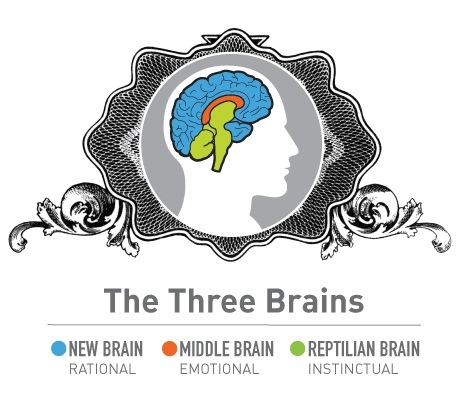Neuromarketing is more commonly known is advertising, but did you know it’s also used in web design ? In this case, the goal of neuromarketing is to increase conversion rates and the percentage of visitors who take action by using specific cognitive biases in the design and content of the website.
Researchers have begun to study the way the brain works in response to marketing stimuli. By understanding the consumer’s cognitive and sensory responses, you can fine-tune your web design and encourage conversions.
Now, let’s look at this example for a moment. Out for an evening walk, you nearly step on a snake. It takes your brain only milliseconds to respond to the potential threat, causing you to stop short and take a closer look. By the time you jump back, you realize it’s just a stick. But your primitive brain responded before you could really process what you were looking at and come to a rational decision to just keep walking.
What can we draw out of this example – what have an evening walk, a snake and a branch got in common with websites ? Well, consumers work the exact same way when they click on a website. The job of the primitive brain is to keep us alive, therefore it’s hard-wired to process external stimuli in a certain way. This means that our logical and emotional thinking only kick in when our primitive brain is sure everything is alright. As a consequence, this phenomena, has a fascinating impact on web design.

Is the environment familiar ?
The primitive brain, also know as the reptilian brain, is built for efficiency and therefore looks for familiar patterns. As a result if you come across something that isn’t easily recognizable, you may create an interrupted experience for your visitor as their brain assesses for danger. But how can you resolve this dilemma ? Well, for example, you could add pictures or videos of people, like themselves, smiling so that the customer feels reassured. An other way of keeping your customers primitive brain at ease is to keep your home page consistent.
Am I safe in this environment ?
But what happens if the reptilian brain does notice some changes in the environment ? Well it automatically focuses on them amd forgets everything else. An unexpected element in your web design acts the same way as a suspicious rustling in the bushes did for our ancestors. If you take this into concideration, you might understand why navigation accounts for 60% of your online success, and as much as 80% for mobile sites. Therefore it’s best to stick to a predictable navigation and layout so that the users experience isn’t interrupted.
For example, most people hate pop-ups; they totally interrupt an expected experience. But our eyes are instinctively drawn to them (even if we don’t want to) to make sure they’re not dangerous. If that pop-up offers a truly compelling offer or enriches the online experience, the brain will remember that in its decision-making process.
Can I see the danger ? Is it close ?
Around half of your brain is used to process visual stimuli, and as a result, once you see something you can’t “unsee” it. For example, how many light switches do you have in your home? To answer this, you probably visualized the rooms in your home, instinctively, and come up with an answer. Our visual sense is heavily used to understand our world, which means that we need to focus website designs on great visuals. Whether it’s photos of your product in action, your employees providing services, or your retail location – great photos give customers something to connect with.
Should I act ? Fight or flight ?
Finaly, we shouldn’t forget that our brain needs to sense some urgency in order to act. We’re more motivated by the possibility of loss than of gain, and we like the idea of something we can have right now. This means you need to include a call-to-action on every page as well as a way to act immediately (newsletter, membership sign-up, contact information, etc.). You may have noticed that you lose interest in a website fairly quickly, therefore websites should present actionable items early and often.
Some neuroscience-based web design techniques make huge differences, others are so subtle, they may give only a tiny improvement making them worthwhile only if you have a lot of traffic.
Remember, every customer has a brains. So even if the environment is brain-to-brain or brain-to-computer, keep your customers in mind when you’re marketing a website or a product. And as consumers, we should all be aware of how marketers are taking advantage of our own biases.
Want to see where I got some of my information ?
Neuromarketing: a layman’s look at neuroscience and its potential application to marketing practice, Douglas Fugate – click here
Doubledome : Web Design with the Brain in Mind – click here
Vertical Response : How Your Brain Sees Your Website – click here
Task based usability tests are a great way to determine how effective the design of your website is. In general, the purpose of the tasks is to locate some information or functionality that is buried in your website. If your website is well designed, the user should have no difficulty completing the task. On the other hand, if it is not, the task can give you some insight as to which areas of your website could use improvement.
LikeLike